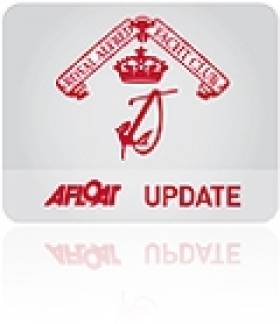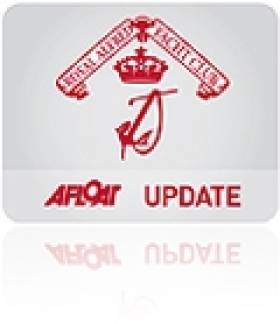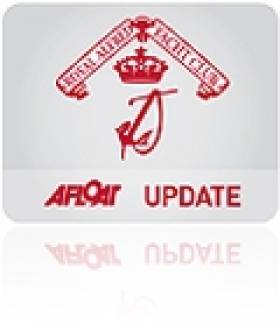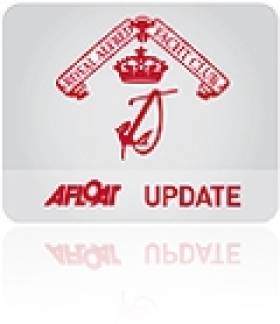Displaying items by tag: Royal Alfred YC
#BAILYBOWL – Dragons, Squibs and RS Elites lined up for the Royal Alfred Baily Bowl one design series at the Royal St. George at the weekend, the modest RS Elite fleet included the recently crowned Miss Northern Ireland Tiffany Brien.
Winds gusting up to 25 knots and a big rolling sea made for challenging conditions for the series on Saturday but winds on Sunday were so light the titles were settled on Saturday's scores.
By far the biggest fleet at this Royal Alfred Yacht Club Championship was the National Squib Class with 13 entries, 3 from the Royal North of Ireland Y.C., 2 from Wexford Harbour Boat and Tennis Club, 2 from the Royal Irish Yacht Club and the rest from the host club the Royal St. George Yacht Club.
Race One on Saturday took place in tumultuous seas (waves up to 3m high) despite the wind strength being about 12 kts. Racing Squibs in these conditions is difficult with many waves breaking over the bows, causing the boats to take water and killing the forward momentum. The windward leeward races were not tactical- but the were won by boat speed and boat handling.
Race One Results: 1st. 'Andromeda', Nigel and Paddy Barnwell RIYC.
2nd. 'Toy for the Boys', Peter Wallace and Kerry Boomer. RNIYC.
3rd. 'Halloween', Fred Campbell. RNIYC
Race two followed immediately afterwards with the seas remaining steep and confused, but the North Easterly wind dropping slightly.
Results: 1st. 'Halloween', Fred Campbell. RNIYC.
2nd. 'Toy for the Boys', Peter Wallace and Kerry Boomer.
3rd. 'Quickstep III', L. Mc.Carthy Nolan & Gordon Patterson.
Race three followed with similar wind and sea conditions.
Results: 1st. 'Perequin', Vincent Delany and Noel Colclough. DMYC.
2nd. 'Quickstep III' L. Mc.Carthy Nolan & Gordon Patterson. RNIYC
3rd. 'Halloween', Fred Campbell. RNIYC
Race four and five on Sunday were abandoned due to a flat calm, no wind and poor visibility.
The Dublin Bay boats achieved two out of three first places but they could not compare with the consistency of the Northern boats, so the final results were:
First 'Halloween', 3,1,3 placings. Sail No. 148.
2nd. 'Toy for the Boys' 2,2,5 placings. Sail No. 818.
3rd. 'Quickstep III' 5,3,2 placings. Sail No. 820.
Best of the rest was 'Andromeda' with 1,4,6 placings.
Best Wexford boat was 'Chubble', Michael Jones. The Wexford club is new to Squibs and they now have a fleet of 7 boats which normally sail above the road bridge in Wexford town in the South Eastern corner of Ireland.
Best all lady team: 'Chillax' sisters Angela Heath and McLoughlin who had the benefit of a double dolphin escort while they were waiting for the second race to start.
Royal Alfred Baily Bowl one design series 2012:
Dragons
1st Sir Ossis of the River Dennis Bergin, 2nd Kin Simon Brien, 3rd Aphrodite Micheal Doorly.
Elites
1st Momentary Laps, John Patterson, 2nd Kin Tiffany Brien, 3rd, Fullmarks Mark Brien.
Squibs
1st Halloween Fred Campbell, 2nd Toys For The Boys Peter Wallace, 3rd Quickstep III McCarthy Nolan and Patterson.
Thanks to Eunice Kennedy and Vincent Delany for assistance with this report
#RAYC – 50 boats entered the Royal Alfred Yacht Club Niobe Trophy, run in conjunction with the last day of the Howth YC Spring Warmer series on Saturday 28th April.
The RAYC Niobe Trophy has long been a feature of the racing calendar in Howth. This year, in a change of format, the Niobe Trophy was sailed in conjunction with the last day of the Howth Yacht Club Spring Warmer Series. In this way, boats had an extra reason to compete on the closing day of the series.
Traditionally both the Niobe Trophy and the Spring Warmer series were events for one-design keel boats. This year they were also open to the Cruiser Classes.
The blustery north easterlies, with associated lumpy seas and cold rain, made for exciting conditions. All classes sailed two races. In keeping with objective of providing additional motivation for crews winning the Spring Warmer series winning boats did not guarantee victory in the Niobe Trophy.
At the prize-giving, RAYC Rear Commodore Joe Carton thanked the owners and crew for ensuring the success of this new formula, which will be repeated next year.
The Royal Alfred Yacht Club will be providing more racing for boats from Howth this year. The revived Royal Alfred Superleague will be open to boats from Howth, with a special welcome this year for the Puppeteers.
|
Boat Name |
Crew Details: |
|
|
Class 1 |
Equinox |
Ross McDonald |
|
Class 2 |
Sunburn |
Ian Byrne |
|
Class 3 |
Starlet |
Bourke/others |
|
Etchells |
Kootamundra Fetching |
Dan O’Grady Stephen Quinn / Des O’Flaherty |
|
SB3’s |
Sharkbait Dinghy Supplies TBC |
Ben Duncan / Moran Shane Murphy Ronan Downing |
|
Puppeteers |
Trick or Treat Harlequin |
Alan Pearson Dave Clarke / Liam Egan |
|
J24 |
James Encore Hard to Port Kilcullen Euro Car Parks |
J.P. Caldin Flor O’Driscoll HYC Team 25 |
|
Squib |
Kerfuffle |
Jonathan Craig / Hazel Ruane |
RS Elites Add Colour to Baily Bowl Weekend
Low pressure systems played havoc with the Royal Alfred YC Baily Bowl on Dublin Bay this weekend with visitors from Belfast Lough adding much needed colour writes our Dublin Bay Correspondent. The one design fixture struggled to attract big numbers in any of the four fleets sailing and the local Flying fifteen class opted out altogether.
The one design weekend is part of the 2011 Royal Alfred Season.
Race officers Brian Reddy and Barry MacNeany succeeded in completing three races on Saturday on both race courses but 50 knot gusts on a white Dublin Bay put paid to Sunday racing entirely.
Simon Brien from Cultra sailing Kin won the six boat Dragon fleet with two firsts and a second from Richard Goodbody and the Johnson Brothers Diva. Next week the class East coast championships will be held on the bay.
Peter Wallace's Toy for the Boys took the Squib class from local Frank Whelan in Lola.
Vincent Delany, a favourite for the Squib event, didn't show his usual form in third returning twice at starts and struggling up through the fleet.
Requests for redress from the race committee after recall signal misfire were denied according to the RAYC.
Peter and Marie Dee in Kookaburra after winning race two, lost third place overall to Delany after retiring from the final race.
In the six boat RS Elite fleet which decamped from the shores of Belfast Lough, Tiffany Brien crewed by Jay Bourke tied with John Patterson in Momentary Lapse on 7 points but lost on tie break. The Laser radial sailor still beat her uncle Mark in Full Marks!
Trevor Darcy and Simon Hutchinson from Carrrickfergus in Bullet won the SB3 fleet by a point from Colin Galavan's Defiant after the fleet retired from the final race as the wind touched force six.
There were two windward leeward races on Saturday morning staged for a fleet of seven J109s and six Sigma 33s. Results from Saturday afternoon's regular DBSC racing were then added to the score tally. The full results are: Sigma 33: 1. White Mischief (Tim Goodbody) 2. Rupert Dick Lovegrove 3. Alandra. (John Molloy) J109: 1. Joker (John Maybury) 2. Storm. (P. Dillon) 3. Jalapeno (Dermod Baker).
The second part of the Baily Bowl one design competition will be held next weekend for Dragons, Flying fifteens, Squibs and SB3s, although that sportsboat class says it has not had much local take up for the event to date.
25 Entries for ISORA's M2 Buoy Race
25 sailing boats are entered for this Saturday's Dun Laoghaire – ODAS M2 Buoy – Dun Laoghaire race starting at 10 am. This is the eighth race of the ISORA series and it is organised in conjunction with the Royal Alfred Yacht Club. The start line will be located in Scotsman's Bay in the vicinity of DBSC 'Pier' mark between the mast of a committee boat flying the RAYC burgee and a start mark at the port end. An entry list and sailing instructions are attached.


























